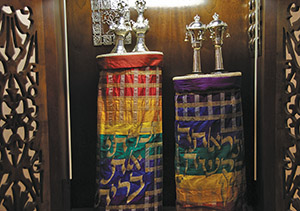
Well before the concept of a safety deposit box was introduced, God told Moshe that there was one item that must be securely stored. Moshe was instructed to place the luchot (tablets) that he received when he ascended Mount Sinai into the holy Ark, which was to be found in the innermost chamber of the Tabernacle. In Exodus (25:16) we read, “And you shall place into the ark the testimony, which I will give you.”
At first glance, this commandment had a very limited scope. After all, how often are we receiving tablets from God? Interestingly, Maimonides writes that God’s commandment to Moshe regarding the luchot created a paradigm which must be emulated in every synagogue for all generations. Namely, just as the tablets were stored in a special vessel, we must construct an ark in which we place our Torah scrolls (Laws of Torah Scrolls 10:10).
However, there is one subtle, yet critical, difference between the manner in which the luchot were placed versus the way in which we store our Sifrei Torah. The luchot were placed in the Ark in a resting, horizontal position while Torah scrolls are stored upright, in a vertical position. This difference prompted Rabbenu Tam (cited in Hagaot Maymoniyot ibid.) to suggest that the ideal resting position for Torah scrolls is lying flat, horizontally.
Rabbi David ben Zimri (Shu”t Radbaz 3:630) notes that since Jewish communities throughout the world store their Torah scrolls in an upright position there must be a valid explanation for this prevalent custom. He goes on to offer a number of explanations for the difference in positions. One particular difference reflects a powerful lesson for us to consider on Shavuot. The Radbaz writes that the luchot are placed in the Ark for safekeeping but God never intended for the Jewish people to use these luchot on a daily basis. The luchot represent the moment when the Jewish people received the Torah at Sinai and, as such, they were meant to be stored as a beloved piece of Judaica for perpetuity. The luchot rest “lying down” to reflect their static symbolism.
However, Torah scrolls embody a completely different message. The Torah is defined as a “tree of life” specifically because of the Torah’s unique ability to be applied and adapted for every generation. While the laws of the Torah are immutable, the questions Torah scholars face in one generation are markedly different from the questions asked in a different generation. Just as a tree blossoms and gives fruit year after year, the Torah has a never-ending ability to guide our thoughts and actions even as new issues surface.
The Radbaz suggests that our Torah scrolls are stored in an upright position to reflect this dynamic beauty of Torah. Unfortunately, there are those who believe that the laws of the Torah are “outdated” and “irrelevant.” However, all we have to do is open up every ark throughout the world and observe our Torah scrolls standing tall to remind ourselves of the magnificence of our tradition. The Jewish people are blessed with a wellspring that continuously refreshes itself and provides life to all those who drink its waters. The holiday of Shavuot is a particularly opportune time to recommit oneself to appreciating this particular dimension of Torah.
Rabbi Zev Goldberg is rabbi of the Young Israel of Fort Lee.
By Rabbi Zev Goldberg













